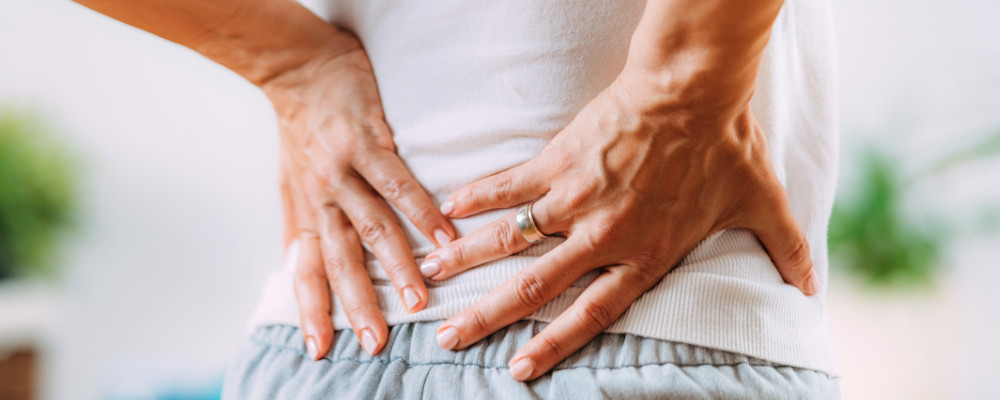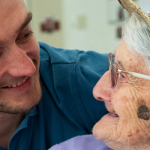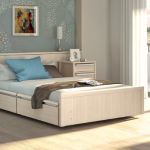Five expert tips for carers on how to protect the back while working.
Carer Anna is under stress: important documents still need to be recorded, Mrs Schmid at the end of the corridor needs help, her catheter needs changing and Mr Maier has also wandered downstairs in his bed, lying like a frog with his legs spread out at the foot of the bed. Anna quickly tries to help the old man up and pulls him jerkily up to the head of the bed. Not a good idea. Around five times her body weight is now bearing down on the carer’s intervertebral discs. The problem: careless lifting can quickly lead to a slipped disc. Scenes like this are commonplace in care homes and hospitals. But how can back-friendly work be organised?
Protecting your back with different belief systems

Caritas Munich has been employing a mobility and ergonomics coach for almost four years: Kai Pietzner is a physiotherapist and recently won the Innovation Award from the German Association of Catholic Care for the Elderly (VKAD) for this job profile and the associated offer for care staff. The expert says: ‘Many professionals struggle with the patterns they have learnt: they have to work quickly and efficiently. They lose focus on themselves in the process.’ Pietzner points out that carers‘ resilience and mental health have not only suffered since coronavirus. Mental training can therefore help to release these old, repetitive patterns and beliefs. This should ultimately strengthen communication between carers and residents or patients. Ergonomic training, on the other hand, shows how working posture at the care bed can be improved.
Involving residents
According to Pietzner, a lack of communication in particular makes everyday work more difficult. The ergonomics coach advises: ‘Always involve the patient.’ This is because the resources of the person being cared for are often not recorded, such as whether patients are cognitively able to understand what is being said. Can the patient lift their arms, perhaps pull their leg over on their own? By speaking to them, you can find out which movements are possible or what they can still do on their own. Tactile stimuli and encouragement also help to establish contact. Dialogue also helps patients to strengthen their independence and remain mobile.
Demonstrate an ergonomic posture
Correct posture is crucial to avoid back injuries. A carer moves or mobilises residents up to 50 times a day. Even sitting up to wash or eat is difficult for many older people. However, incorrect assistance for this puts immense strain on the carer’s musculoskeletal system.
Pietzner advises: ‘If possible, always adopt a straight posture, pull your shoulders back and distribute your weight evenly on both feet.’ Bend your knees slightly to reduce the load on your back. Avoid bending over and twisting your spine. And only mobilise the resident after checking their own posture.
Physiotherapist Pietzner offers training courses at his employer in which specialists learn supportive movement techniques. One focus here is on the correct stance. ‘Take the strength from your legs instead of your back,’ says the expert. He also advises: ‘Work as a team to distribute the load better. Two people can mobilise a patient much more quickly and (back) gently!’
Also important: regular breaks provide brief relaxation. Light stretching and stretching to pump blood into the muscles also prevents strains.
Use aids, protect your back
Pietzner works with the TOP method, which is divided into three levels: technical, organisational and personal. Aids belong to the technical level. The movement coach knows how rarely some aids are used. He sees the reasons for this in the shortage of skilled labour. Many older carers also find it difficult to try out new aids. ‘But by using sliding boards, lifting cushions or slings, carers gain time,’ says the coach.
Pietzner explains: ‘During a difficult transfer of an elderly lady, a simple slide board with a handle helped her to slide into the wheelchair. The injured leg could be mobilised stably and without touching the floor. ‘Using muscle power alone could have caused serious injuries on both sides.’
Adapting the care environment
In order to have the aids to hand, the back specialist recommends placing a kind of clothes rack in each room. Equipped with cloths, slip mats or stand-up aids, the carers would see them and be encouraged to use them. Improved room equipment so that care utensils and medication are within easy reach also makes work easier and avoids frequent bending. Pietzner’s tip: ‘Incontinence pads and wound creams can be wonderfully stored on a small shelf at eye level.’


